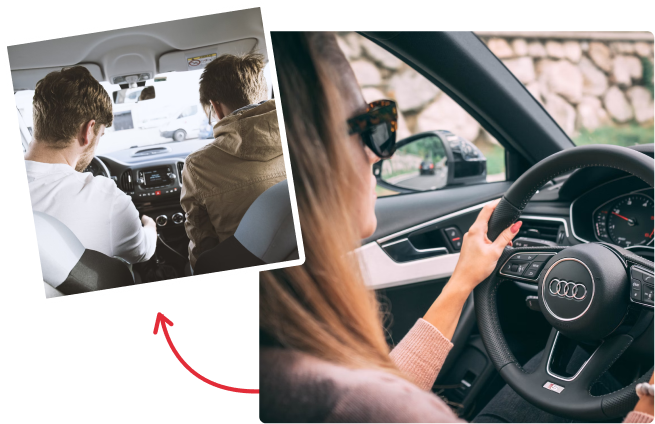What is Hydroplaning ?
To define, What is Hydroplaning which is also referred to as Aquaplaning? It is the uncontrollable sliding of car tires on wet surfaces. Hydroplaning is the most common cause of accidents which may happen due to the bad condition of tires. Driving at high speed and poor road conditions can also be a reason for Hydroplaning.
It can turn a steady flow of traffic into a nightmare. Losing control of your vehicle, and not knowing what to do, is quite scary. All of this can happen so abruptly that you might be unable to think properly. A single rain cloud can result in Hydroplaning. The thin layer of water from that cloud can separate the wheels of a moving car from the road surface. It can result in loss of power and steering control.
Read also: What is Defensive Driving? || Defensive Driving Course
How Hydroplaning Happens?
Several reasons can lead to Hydroplaning. It occurs when the tire grooves cannot pump water away from the contact patch. The contact patch is where the rubber meets the road. It is estimated by Tiremaker Continental that, on average, a new tire can disperse about eight gallons of water per second at 50 mph.
But when a tire cannot disperse the water, a thin layer of water is created between the tires. This causes the tire to lose contact with the road surface. It can be dangerous, and the driver can lose the steering power.
What is Hydroplaning caused by?
Some other reasons that can cause hydroplaning are:
- Road surface and Drainage conditions- They can play a crucial role in triggering the effects of Hydroplaning.
- Rainy Weather- There is a risk for the vehicles to Hydroplane if rainfall intensity is high. Water present on the road surface can also be a factor.
- High Speed- Another reason for vehicles to skid is because of high speed. Tires need some time to remove water from the surface of the road and their treads. High speed is why tires can’t get enough traction, resulting in Hydroplaning.
- Tread Depth- A crucial factor in preventing Hydroplaning is tire tread depth. Changing old worn-out tires and replacing them with new ones is necessary to ensure safe driving. An easy way to check tire tread depth is through the “Penny Test.”
- Heavy Vehicles- These vehicles also have an advantage in resisting Hydroplaning. The reason is due to the extra force they have to disperse water.
Precautionary Measures to prevent Hydroplaning
As discussed before, Hydroplaning is a result of multiple reasons, some of which are uncontrollable. But still, by performing necessary precautionary measures, dreadful hazards can be prevented. Hydroplaning does not have to be scary.
Conditions are not always in our favor, and we can’t control them. Still, some preventive measures can help save the lives of others and our dear ones. Some safety measures that can be helpful in such a situation are as follows:
- Reduce Speed- The leading cause of hydroplaning is rainy weather. So it is advised to reduce speed in such conditions. The faster the speed, the harder it is for the tires to scatter water around.
- Maintain Quality of Tires- It is necessary to check the tires at least once a month and remove worn-out tires. Tires should be properly inflated. It is necessary to check the tread depth. The tread depth should be at least 2/32nd of an inch. It will lessen the probability of a hydroplaning event happening.
- Inflate Tires properly- There is an increased chance for the underinflated or overinflated tires to experience Hydroplaning. Tires should be inflated properly and regularly. Properly inflated tires also have an advantage. They don’t need to be replaced frequently compared to improperly inflated tires. It is also advised to balance and rotate tires regularly. It will help to extend the tread life of a tire. A standard recommendation for tire rotation is about every 5000 – 6000 miles.
- Turn off Cruise Control- Although cruise control is an efficient feature that is useful for long drives. It provides the utmost level of convenience. But on rainy days, the scenario is the opposite. It is advised for drivers to rely on manual controls to pay proper attention to the road. In case hydroplaning occurs during cruise control, the driver will need to disengage the cruise control device. This process can take a reasonable amount of time.
- Avoid Water and Puddles- Drivers need to slow down when roads are wet. They need to avoid puddles if possible. It might not be dangerous on a normal day, but during rainy days, it can lead to some serious events. So it’s better to avoid puddles and water standing on the roadside. All of these measures can help prevent Hydroplaning events.
Tips if the Vehicle Starts Hydroplaning/Aquaplaning
These are some tips in case the car starts to Hydroplane:
- Do not panic, and try to keep a clear head. Panic can only worsen the situation.
- A significant mistake drivers make is stepping on the brakes. Instead, the foot should be taken off the accelerator so the car can slow down. Applying brakes can cause the vehicle to spin completely and lose control.
- The steering wheel should be kept steady to prevent the car from losing further traction.
- Wait for a few moments to try to relax and calm down.
Conclusion
Hydroplaning events are the most common but are also avoidable causes of accidents. When light rain mixes with the oil splatters on the road, it creates a slippery place. This can cause the cars to skid. This is known as Hydroplaning. This can be dangerous for the surrounding motorists as well. Hydroplaning can occur in an instant leaving the driver in shock. It’s a dangerous condition that can be fatal in some cases.
G-Class Drivers provide you the complete instruction about driving and next-level education. Even Though Hydroplaning can occur on any wet surface, the chances are much increased during the first ten minutes of the rain. Whether it’s for a few seconds or an instant, it could still be dangerous. Most automobile experts agree that Hydroplaning can occur at a speed greater than 35 miles per hour. There is a need for drivers to take driving courses and extra precautions under such circumstances to avoid any accidents.





